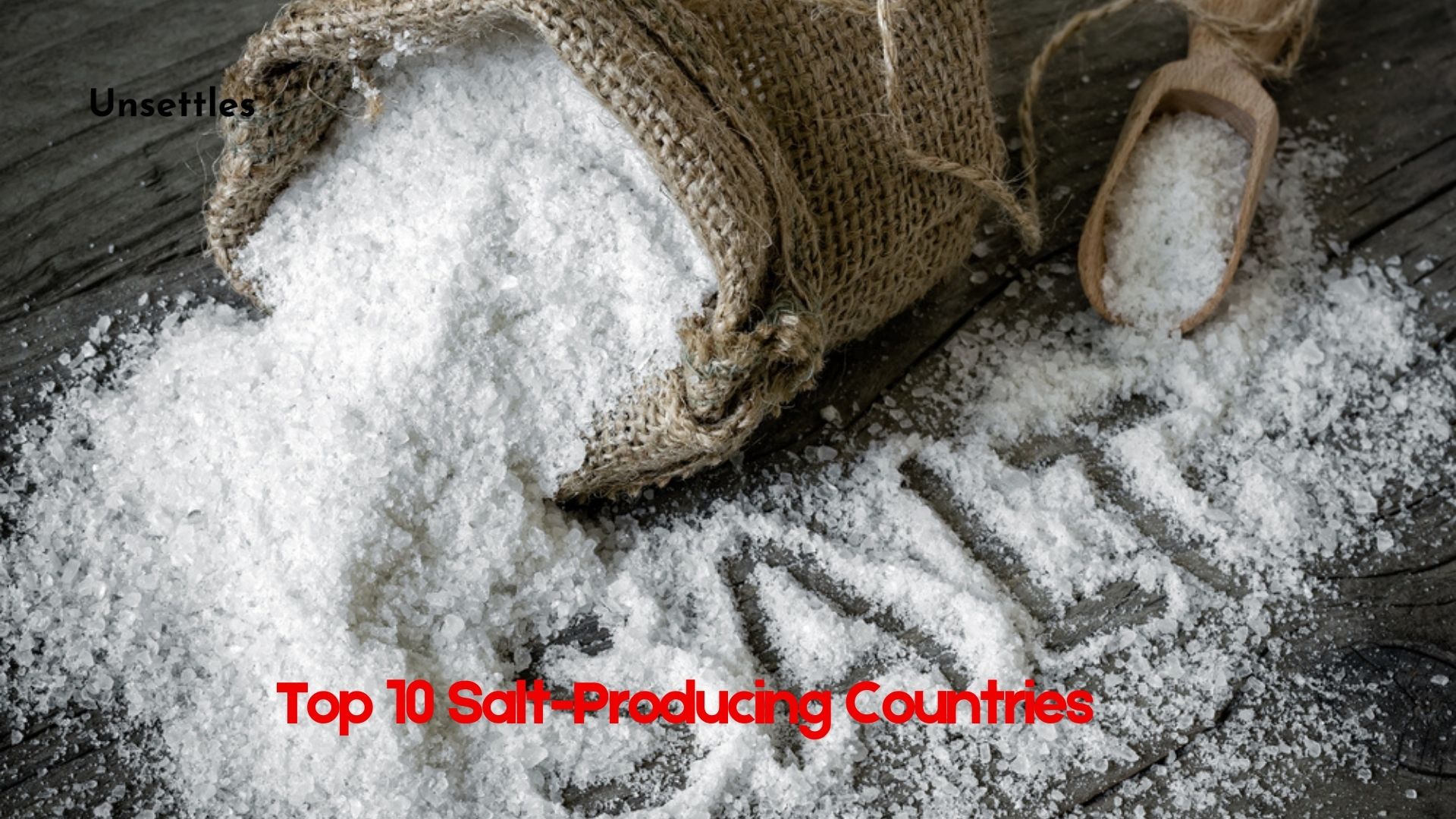Salt-Producing Countries: Salt is one of the most valuable and versatile minerals on Earth, essential for both life and various industries. Used to preserve food, enhance flavor, and even as a form of ancient currency, salt continues to hold a significant place in modern economies. Despite changing demands, the need for salt remains constant, and a few key countries lead global production. This list highlights the top 10 salt-producing nations, showcasing their contributions, extraction techniques, and the role they play in maintaining this vital resource.
Leading Salt Producers Worldwide
China – 64 Million Metric Tons
China dominates global salt production with a staggering 64 million metric tons annually. China’s vast coastal areas and extensive salt flats simplify large-scale salt extraction, primarily through solar evaporation in provinces like Shandong and Sichuan. Chinese salt production feeds both domestic and international markets, keeping pace with its industrial and population needs. By combining natural and industrial techniques, China remains a pivotal supplier in the global salt ecosystem. Salt-Producing Countries
India – 45 Million Metric Tons
India ranks second, producing 45 million metric tons of salt each year. With a sprawling coastline and many inland salt pans, regions like Gujarat and Rajasthan contribute to India’s output, primarily through traditional sea and solar evaporation methods. India’s extensive salt production supports both its domestic market and its exports, particularly in Asia and Africa.
United States – 42 Million Metric Tons
The U.S. produces around 42 million metric tons of salt annually, placing it third on the list. With major salt-producing states like Louisiana, Texas, and Ohio, the U.S. relies heavily on mining and evaporation methods to support its food, chemical, and winter de-icing industries. As one of the top consumers and producers, the U.S. plays a crucial role in the global salt economy, especially in sectors where salt is a critical input. Salt-Producing Countries
Germany – 15 Million Metric Tons
Germany ranks fourth, producing 15 million metric tons annually. Known for high-quality rock salt, Germany’s production is mainly concentrated in Bavaria and Saxony, where solution mining and rock salt extraction are common. German salt is prized for its purity and is essential in the food, pharmaceutical, and chemical industries. With an efficient infrastructure, Germany consistently meets high domestic and global demand.
Australia – 13 Million Metric Tons
Australia’s 13 million metric tons of annual salt production is primarily achieved through solar evaporation. The country’s sunny climate and vast salt flats, especially in Western Australia, make it ideal for this method. Australia’s salt production supports industries both domestically and in nearby Asian markets, solidifying its place in the global supply chain. Salt-Producing Countries
Canada – 11 Million Metric Tons
Canada’s annual production of 11 million metric tons of salt is split between rock salt mining and brine evaporation, with salt-rich regions like Ontario and Quebec playing central roles. Canada’s salt is particularly important in winter, as it’s used extensively for de-icing roads and ensuring transportation safety, underscoring its economic and industrial significance.
Mexico – 9 Million Metric Tons
Mexico produces around 9 million metric tons of salt each year, benefiting from a long coastline along both the Gulf of Mexico and the Pacific Ocean. The salt industry in Mexico plays a crucial role in agriculture, food processing, and chemical manufacturing. With efficient extraction techniques and ideal coastal conditions, Mexico remains a strong player in North and South American markets. Salt-Producing Countries
Chile – 9 Million Metric Tons
Chile matches Mexico’s output at 9 million metric tons, with the majority of production taking place in the Atacama Desert. Utilizing solar evaporation ponds, Chile’s salt production is both sustainable and effective. The region’s abundant sunlight makes it ideal for salt extraction, allowing Chile to remain a steady supplier to global markets.
Brazil – 7.4 Million Metric Tons
Brazil’s salt industry produces 7.4 million metric tons each year, largely from coastal areas and salt pans in northeastern states. Brazil’s diverse production methods allow it to support various sectors, from food processing to chemicals, making it a critical supplier in South America and beyond. Salt-Producing Countries
Turkey – 6.9 Million Metric Tons
Rounding out the top 10, Turkey produces 6.9 million metric tons annually. Turkey employs both rock salt mining and solar evaporation, utilizing its natural resources and varied terrain to maintain steady production levels. Turkey’s salt production supports local industries and provides a steady export flow to Europe and Asia.
Conclusion
Salt remains one of the most valuable and versatile minerals worldwide. As global demand continues to grow, these leading salt-producing nations are essential in ensuring a consistent supply of this resource, which is critical to many industries. From China’s coastal salt flats to Germany’s deep salt mines, each country’s production strategy highlights unique geographical and technological advantages that help meet the world’s needs. Salt-Producing Countries
FAQs about Salt-Producing Countries
What are the primary uses of salt globally?
Salt is used in various industries including food processing, agriculture, de-icing, and chemical production. It’s also essential in certain industrial processes, such as water treatment and pharmaceutical manufacturing.
How does China maintain its position as the world’s top salt producer?
China leverages its extensive coastal areas and large salt flats, along with a mix of traditional and modern extraction techniques. This combination of resources and methods supports large-scale production for domestic and global use.
Why is salt production so high in Australia?
Australia’s climate is ideal for solar evaporation, a cost-effective method that uses natural sunlight to evaporate seawater, leaving salt crystals. Western Australia’s salt flats make this process efficient, contributing to Australia’s high production levels.
What makes Germany’s salt highly valued?
German salt is prized for its purity and is widely used in food, pharmaceuticals, and chemical industries. The country’s focus on high standards and advanced mining techniques also ensures reliable quality.
Is salt production sustainable?
Many salt-producing countries use sustainable methods, such as solar evaporation, which minimizes energy use. Additionally, advancements in mining and extraction help reduce the environmental impact of salt production.
